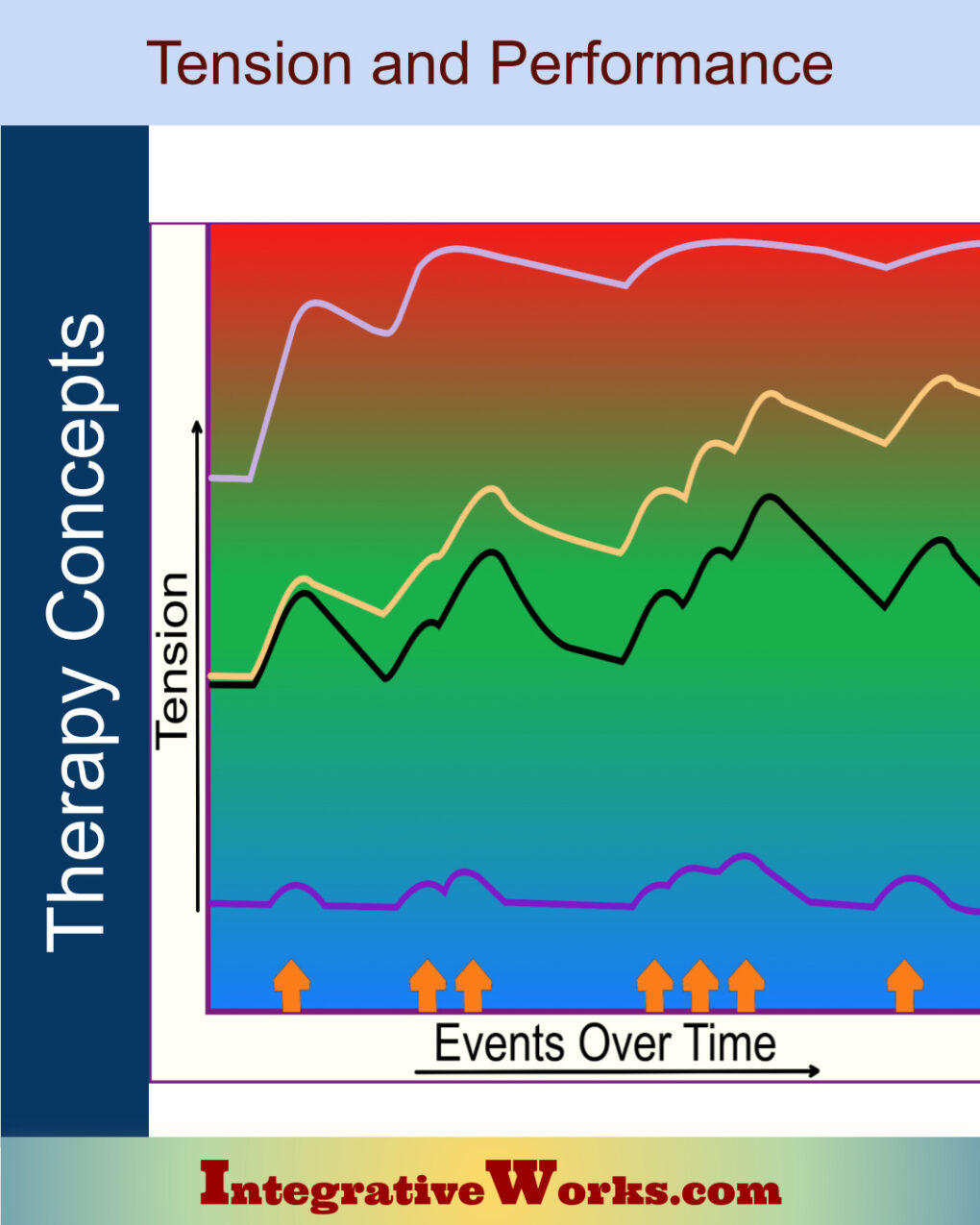Introduction
Here, we explore the concept of Holistic Performance. Otherwise stated, we are exploring how people respond, regulate, and recover in relation to accomplishing tasks at hand. As structural therapists, these concepts lay the groundwork for a discussion on Structural Performance.
First, let’s take a glance at The Holistic Model. This will help us define performance in general. Afterward, we can define Structural Performance, which is bodywork’s target.
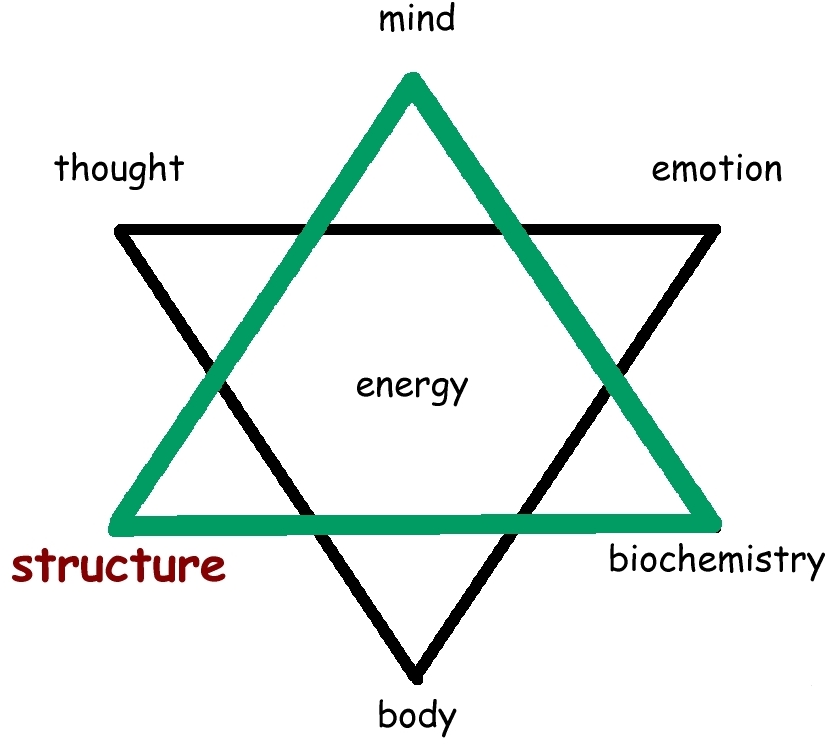
Holistic Approaches
The treatment of a person as a whole characterizes holistic healthcare. It means that all the parts are related and that they interact. Moreover, it means that they are best addressed with consideration of the other parts.
In this model, let’s look at the green triangle. It considers the interaction of mind (M), structure(S), and biochemistry(B). Here are a few simplistic considerations in the holistic model:
- Any counselor (M) will tell you that there are postures(S) of anger and sadness. They will also tell you that your state of mind impacts your immune system(B).
- Pharmacologists and nutritionists(B) will assert that biochemistry plays a big part in muscle tone and bone structure(S). Also, biochemistry affects your attention, alertness, and mood(M).
- Bodyworkers(S) see their clients become less irritable and better regulated (M). Also, tight structures can reduce blood flow and impact the delivery of nutrients(B).
Performance in the Holistic Model
The ability to succeed
in a wide variety of scenarios
indicates good performance
Indicators of Good Performance
Performance refers to taking in input, processing it, and producing appropriate responses. This keeps the system working as it receives stimuli, responds, and recovers.
It is easy to assume that functioning well in demanding scenarios indicates good performance. But, conversely, working well with mundane tasks is also essential. In addition, quick and successful transitions between the intense and mundane demonstrate exemplary performance.
Notably, performance is a continuum. We tend to think of improving or optimizing performance. Even when things perform very well, we still strive for better performance. In perspective, therapy is primarily about improving physical performance. Satisfying performance varies dramatically from one person to another.
Good performance
shows the ability to
Respond
Regulate
Recover
Transition
Indicators of good mental performance:
⦁ attending to the task at hand when it is complicated or mundane
⦁ the ability to quickly organize changing tasks
⦁ easily multitasking or single-tasking
⦁ easy transitions from one activity to another
Indicators of good biochemical performance:
⦁ good digestion
⦁ modulating sensory input
⦁ reduced allergic reactions
⦁ ability to transition from sympathetic to parasympathetic dominance
⦁ good circulation
⦁ balanced endocrine function
As holistic practitioners, we are interested in the interplay of the system. However, as bodyworkers, we are most interested in structural performance.
Indicators of good structural performance:
⦁ coordination
⦁ balanced musculoskeletal development
⦁ appropriate ranges of motion
⦁ quick transitions between physically demanding tasks and physically easy tasks
⦁ modulate pain and irritation
It isn’t easy to talk about structure, mind, or biochemistry without talking about all three.
Embodied Performance
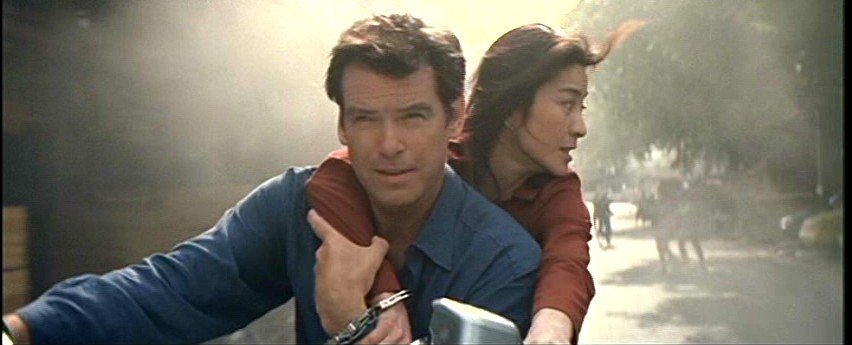
James Bond embodies Integrated Performance. His ability to respond, regulate, recover, and transition is superhuman.
He has a good fashion sense. Further, he is brilliant, witty, and adept at social gatherings. Shortly afterward, he steps out on the balcony and whips half a dozen Henchmen. Cooly, he shakes it off with a ruffle of his jacket. Next, he stops by to sensitively crack the safe and take the top-secret widget. Then, confidently, he steps back into the party. On the way out, he charms the beautiful vixen and takes her home for an unforgettable night. All of this happens in the body of a middle-aged man who lives on very little sleep, rich food, and martinis.
He embodies excellent response, great recovery, and remarkable transition. Great mind, great structure, and great biochemistry. Our hero.
Simple Tension Model
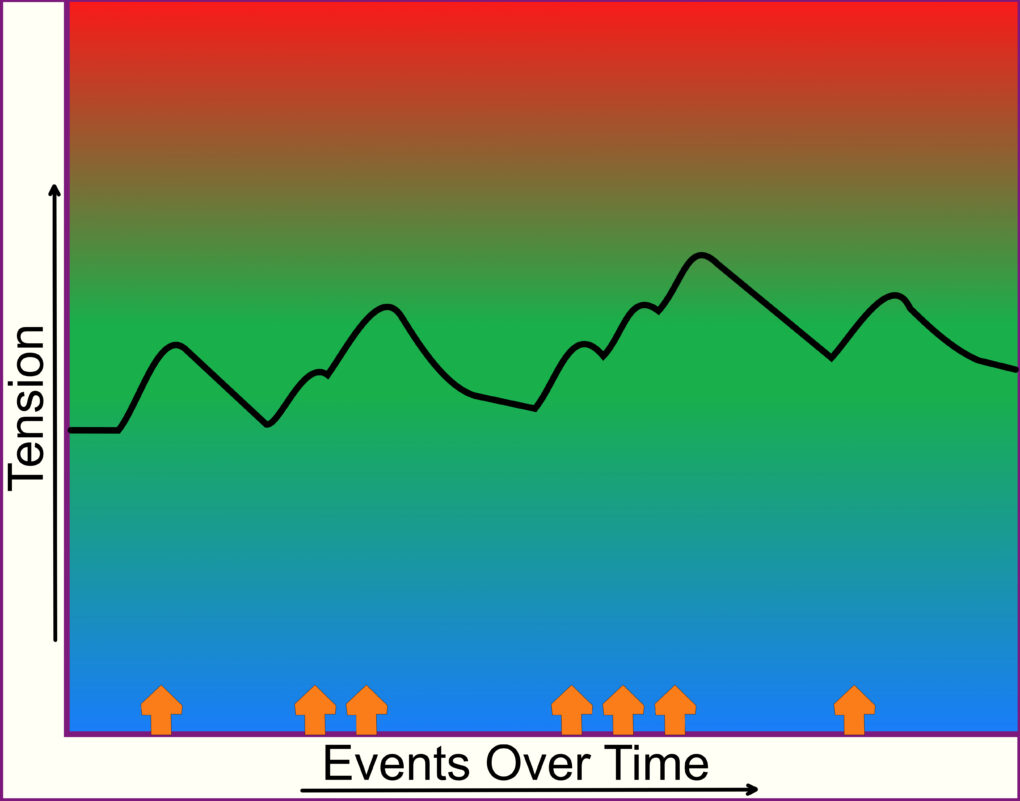
Scaling Tension Over Time
This illustration provides context to follow levels of tension over time. The black line represents how tension might increase (respond) and decrease (recover) in response to events (stimuli).
Stimuli
The orange arrows represent activities that stimulate. This could be external stimuli like loud noises, temperature changes, or being attacked. On the other hand, it could be internal, including digestion, illness, anxiety, or pain.
The Window of Performance
When the tension level is green, we perform well. People describe themselves as productive, “in the zone,” or pleasantly happy in this state. This is the Window of Performance.
Low Tension
When the tension level is blue, there is not enough tension to maintain focus and perform well. At this level, we tend to shut down. People describe themselves with words like tired or bored. For example, this might happen when watching a gentle sitcom after a long day and dozing off.
High Tension
When the tension level is red, there is too much tension. Consequently, we have trouble focusing. People describe themselves with words like anxious or irritated. Notably, these people might also be described as giddy or overly excited. So, it is important to understand that the ability to perform is compromised, not that they are happy or sad. For example, this might happen when you’re having trouble working after receiving bad news. As well, this might happen when trying to work after winning the lottery.
Straying from The Window of Performance
Again, this is a simplified model. Therefore, it doesn’t explore subtle gradients or the complexity of overlapping events.
However, it is important to realize that as we stray from The Window of Performance, we begin to falter. We may drop tasks or be unable to perform them proficiently. At a point, we tend to have dramatic reactions where we fail to perform. Colloquially speaking, we melt down or shut down. Otherwise stated, we may throw a fit or pass out. Many therapists would say that we go into Fight or Flight mode. We should add Freeze to that.
Changing Tension
Performance depends on the body’s ability to take in stimulus and manage tension. Typically, tension increases when there is more intensity, complexity, or novelty.
We naturally adjust
our level of tension
to maintain focus
and improve performance.
The nervous system works to optimize our performance so that we can function without impairment. It is our natural tendency to regulate tension. Often, we increase or decrease tension subtly by tapping our fingers, eating, or adjusting our posture. At times, we regulate tension overtly with activities like drinking, showering, or listening to music.
Pacing helps some people to think while talking. Conversely, pacing distracts some people while talking. Each of these describes a person with a different response and recovery to a typical activity of daily living.
Intensity
In this context, “intensity” refers to a change in amplitude. The stimulation becomes louder, harder, hotter, colder, faster, etc.
Complexity / Limitations
Complexity refers to a change in the number of factors involved. For example, we may begin fidgeting with a pen while studying. This added complexity can be stimulating. Consequently, it makes us more alert.
Novelty
Learned pathways are reflex paths that we develop by doing the same thing repeatedly. Learned pathways remove our need to consciously think about tasks like gripping our phone, sipping from a drink, or driving around our neighborhood. Instead, novelty increases the tension by exploring less familiar functions, like using a new app or changing planes in an unfamiliar airport.
Recoverable, Manageable, Unmanageable
Regulating Tension
This idea is explored in the post “Heaven is a Place with Tension.” It is a lighter post and worth reading if you are unfamiliar with this concept.
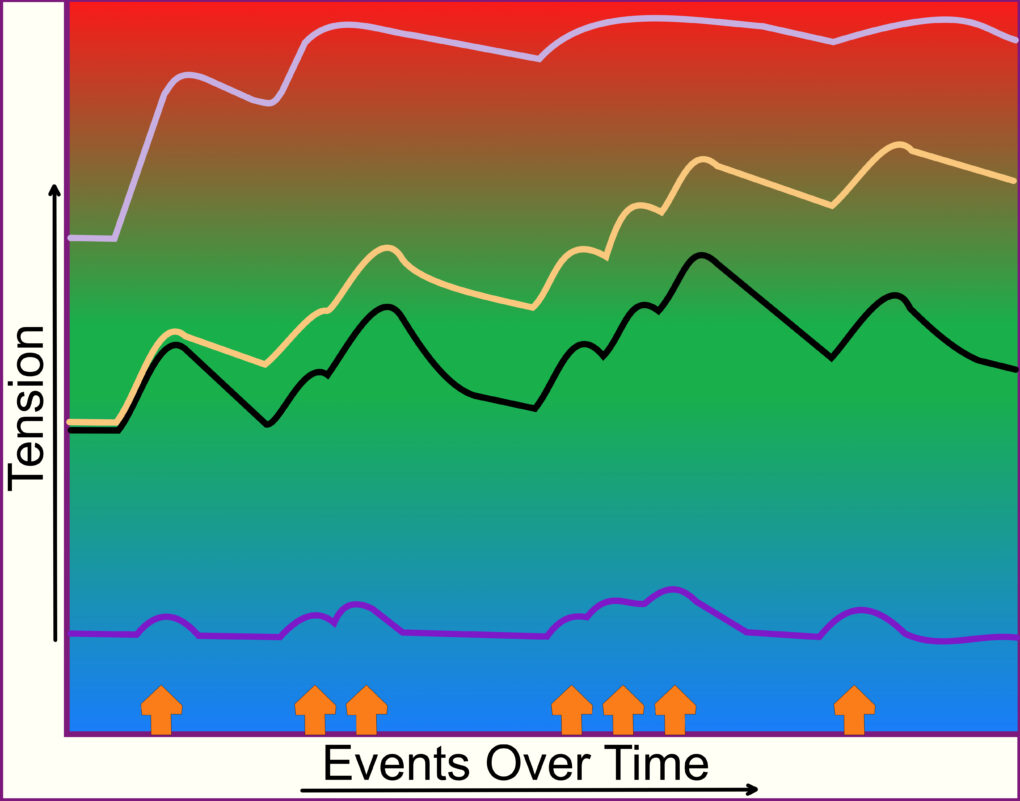
Models of Performance
This example may represent 5 minutes, 5 hours, or 5 days. It is just a model to demonstrate a simplified point. In this example:
Well-Regulated
The black line is well-regulated. This person has good responsiveness and recovery. This helps keep tension in the Window of Performance.
Poor Recovery
The yellow line has about the same response to stimuli as the black line. However, they lack good recovery and have trouble staying in The Window of Performance. This person often seems a bit moody but returns to a good place when given the proper time and change of pace. Also, they perform better when they have more time to transition.
Over Reactive
The lavender line is overly sensitive and has poor recovery. The Sensory Integration perspective sees this person as having “high arousal.” So, this person has trouble getting into The Window of Performance. So, naturally, They look to reduce complexity, intensity, and novelty. They seek calming strategies or sit quietly until they are overwhelmed and then explode or withdraw. They may use painkillers, depressants, and SSRIs to calm themselves.
Under Reactive
The purple line under responds and has a quick recovery. The Sensory Integration perspective sees this person as having “low arousal.” It takes a lot to get this person into The Window of Performance. This person may change the situation by creating complexity or drama. They may put themselves back in the Window of Performance with stimulants like coffee or Ritalin.
Getting into the Window of Performance
The nervous system works to create appropriate responses to stimuli to improve performance.
Our voluntary and involuntary nervous systems generate responses. However, involuntary responses from the autonomic nervous system can limit voluntary responses.
For example, many people experience this when trying to do mundane computer work after a big lunch. The autonomic nervous system has gone parasympathetic dominant. Consequently, it is using the body’s resources to digest cheap carbs. Accordingly, trying to maintain voluntary focus while writing about bodywork physiology after eating french fries is … zzzzz…
There are many subtle ways that we regulate tension.

Getting Regulated
Getting into the Window of Performance can happen in several ways:
Adjust the Activity
Adjusting tension in the activity makes it more or less intense, complex, or novel. Unfortunately, this isn’t always an option.
Adjust your Attitude
“Top-down Management” is the idea that you can focus more on regulating yourself during this activity. Typically, this only works in the short term.

Adjust your Bod
“Bottom-up Management” involves changing your body to be better regulated. This is a common approach. For example, exercise, taking a shower, and deep breathing are often used to modulate reactions. Additionally, drugs and alcohol can regulate reactivity, which helps to keep people in the Window of Performance.
Bodywork is a form of Bottom-up Management. It can reduce responses to pain and, thus, make it easier to stay in the Window of performance.
However, most usefully, it widens the Window of Performance. I discuss this in more detail in the post on Structural Performance.

The Holistic Model
From a Structural Approach
In the Holistic Model, we recognize that many approaches can impact a particular problem. For example, TMJ (jaw) pain may be helped by counseling (mind) to stop clenching. On the other hand, low back pain can be helped with pain creams (biochemical).
Structural practitioners
work with the structure to
improve Holistic performance.
However, we need to consider our influence on the factors of the mind and biochemistry. Also, we need to consider when a structural problem is better served by working with the mind or biochemistry.
Support Integrative Works to
stay independent
and produce great content.
You can subscribe to our community on Patreon. You will get links to free content and access to exclusive content not seen on this site. In addition, we will be posting anatomy illustrations, treatment notes, and sections from our manuals not found on this site. Thank you so much for being so supportive.
Cranio Cradle Cup
This mug has classic, colorful illustrations of the craniosacral system and vault hold #3. It makes a great gift and conversation piece.
Tony Preston has a practice in Atlanta, Georgia, where he sees clients. He has written materials and instructed classes since the mid-90s. This includes anatomy, trigger points, cranial, and neuromuscular.
Question? Comment? Typo?
integrativeworks@gmail.com
Interested in a session with Tony?
Call 404-226-1363
Follow us on Instagram

*This site is undergoing significant changes. We are reformatting and expanding the posts to make them easier to read. The result will also be more accessible and include more patterns with better self-care. Meanwhile, there may be formatting, content presentation, and readability inconsistencies. Until we get older posts updated, please excuse our mess.

